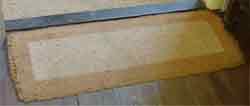The hall and staircase of a typical '1940s house', built 1930s
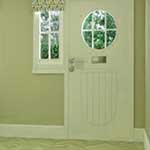
In the 1940s, the British public lived in older buildings with older furnishings because all the country's resources went into the war effort and the recovery afterwards. The newest mass housing was built on housing estates in the late 1930s. This page describes the hall and stairs area in a typical such house as it was in the 1940s.
____
By the webmaster, based childhood observations, discussions with people who lived in these houses and additional research
Floor plan of the hall and stairs layout
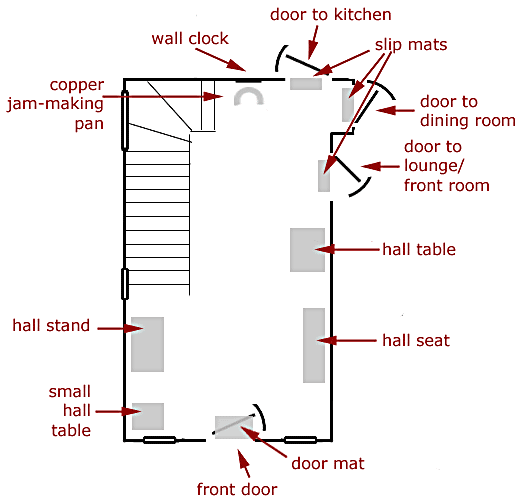
Floor plan of the hall of a fairly typical suburban house as it was in the 1940s, based on recollections of a house in Brook Avenue, Edgware. Although many similar suburban houses had smaller halls, with different embellishments, the basic plan would have been the same.
For how this hall plan fits into the other rooms on the ground floor, see the 1940s house. What seemed to strike our relatives who still lived on the Victorian housing estates was the relatively large sizes of the hall and kitchen.
Naturally, once inside the house, the personal preferences of the occupants showed, although these were dictated by what was still in the shops at the time of purchase and what were hand-me-downs.
The doors
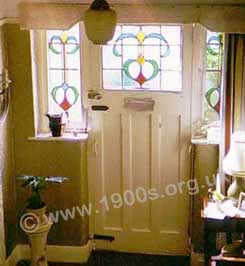
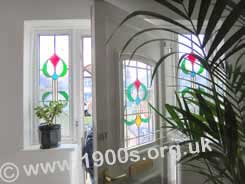
First photo: Original front door, photographed in the 1960s. In the 1930s and 1940s the wood would have been varnished, not painted. Note that the glazing is upside-down compared with that in the second one which was always standard along the road. The main text explains!
Second photo: Modern replacement windows and doors along the road. They have used the original glass in the double glazing. I wonder if today's residents know that the glass panels survived the WW2 bombing.
At the time, our stained-glass hall window seemed to me, as a very young child, like a monster with huge eyes and large shoulders, and I had nightmares about him coming out of the front door towards me. So my father had the windows re-inserted upside down. Then the nightmares stopped.
There was a non-descript coloured curtain that could be drawn across the door and side windows at night - and of course, during the blitz there was the blackout.
The doors from the hall to the rooms were panelled, opened towards the rooms and were varnished like the front door. I think there were eight panels.
Typical hall furniture
What was bought in the late 1930s in the way of hall furnishings would have been typical in style in other houses furnished at that time because it was dictated by what was in the shops. Differences would have been relatively minor.
Our hall floor, like other hall floors, was covered in lino with a dark to medium brown marble pattern. My mother polished it regularly on her hands and knees till it shone.
There were four items of bought furniture, all in dark wood.
- A small table was tucked away inside the front door. It had a drawer with a shelf underneath. Later in the 1950s it was where the one and only telephone was located.
- A slightly larger square table stood by the door to the lounge (or 'the front room' as it was always called). It was a much more elegant affair, comprising a top and a shelf close to the floor. It had turned twisted wooden legs.
- Opposite this table was what was called the 'hall stand'. It was as tall as a man and had hooks for coats and hats, a small mirror and a small seat with a hinged lid over a container for gloves etc. There were slots at the sides for umbrellas. It came in several versions, and every house seemed to have one or another of them in its hall.
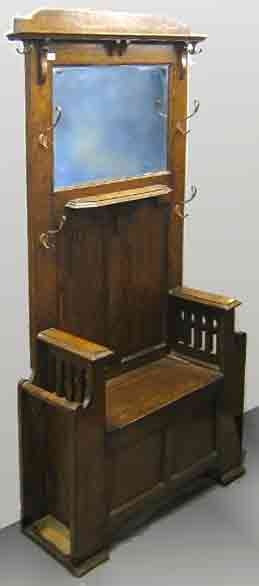
Hall stand, photographed at an auction. Ours was identical apart from the mirror being smaller and oval.
- Between the door to the kitchen and the stairs was a carved wooden wall-mounted clock.
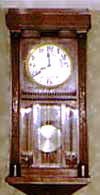
Carved wooden wall clock
Typical hall and stair carpets
- The stair carpet was typical of the time and of previous decades, in that it was not fitted but was a long narrow length held down on each stair with decorative clips at the sides. Decorative rods, like the ones shown in the photo, were also in use. The wooded stairs, varnished as medium coloured shiny wood like the banisters, showed at either side of the stair carpet. Our 'stair carpet runner' had a non-descript pattern with a border along its edges.
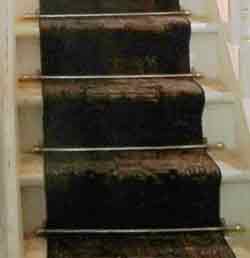
Stair carpet - a long narrow length held down at the edges of each stair with decorative clips and showing the wood of the staircase at each side. Ours was a golden colour.
(Underneath the stairs was a glory-hole cupboard, hidden from view by a partition and door which matched the yellowish varnish of the stairs and banisters.)
- 'Slip mats' were also typical. These were small mats placed in the hall just outside every internal door. Ours were bottle green. I suspect that their purpose was to eliminate draughts from under the doors, as it was not usual to heat all the rooms. The mats were well-named, as they did tend to slip around, particularly on my mother's highly polished lino floor. People frequently almost lost their balance on them.
Slip mat, commonly placed outside internal doors, probably to keep out draughts. Photographed in Tilford Rural Life Centre.
Additionally there was a door mat inside the front door for wiping our feet when we came in. Incidentally it was never deemed necessary to remove outdoor shoes when indoors. Probably that was due to there being no fitted carpets. Lino could be washed and polished as frequently as the housewife felt necessary.
Hand-me-downs and 'heirlooms'
Other items in our hall were not typical in that they were either hand-me-downs from older relatives or bought while 1930s goods were still in the shops.
- Our hall seat was made of two different types of beautifully grained and shining wood. It had been put together by my mother's father, from a broken, but once-expensive grand piano which had found its way to the family from someone better-off.
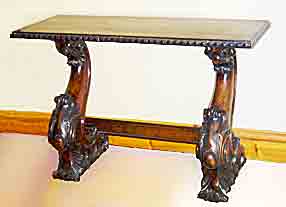
Low, oak polished hall-seat once elegant, made froma a broken grand piano.
- Our large copper pan, by then shining brightly from my mother's repeated polishing, was originally a pan for making jam. It probably came from my mother's grandfather's family as its size suggested that it had been used for large scale preserving. It was propped under the wall-clock.
- Various vases and crochet mats, etc were on surfaces.
The walls
The hall walls were papered in a slightly textured, non-descript beige colour. It was the same throughout the house.
The 'drop ceiling'
Throughout the house, the walls were only papered to within about half a metre of the ceiling. The upper part was known as a 'drop ceiling'. Around the demarcation was a picture rail with a papered frieze below it. Pictures hung from the picture rails. (The drop ceiling and picture rail fashion persisted from the early 1900s, and probably before, until around the 1950s.
Ceilings were whitewashed.
| sources | webmaster | contact |
Text and images are copyright
If you can add anything to this page or provide a photo, please contact me.


